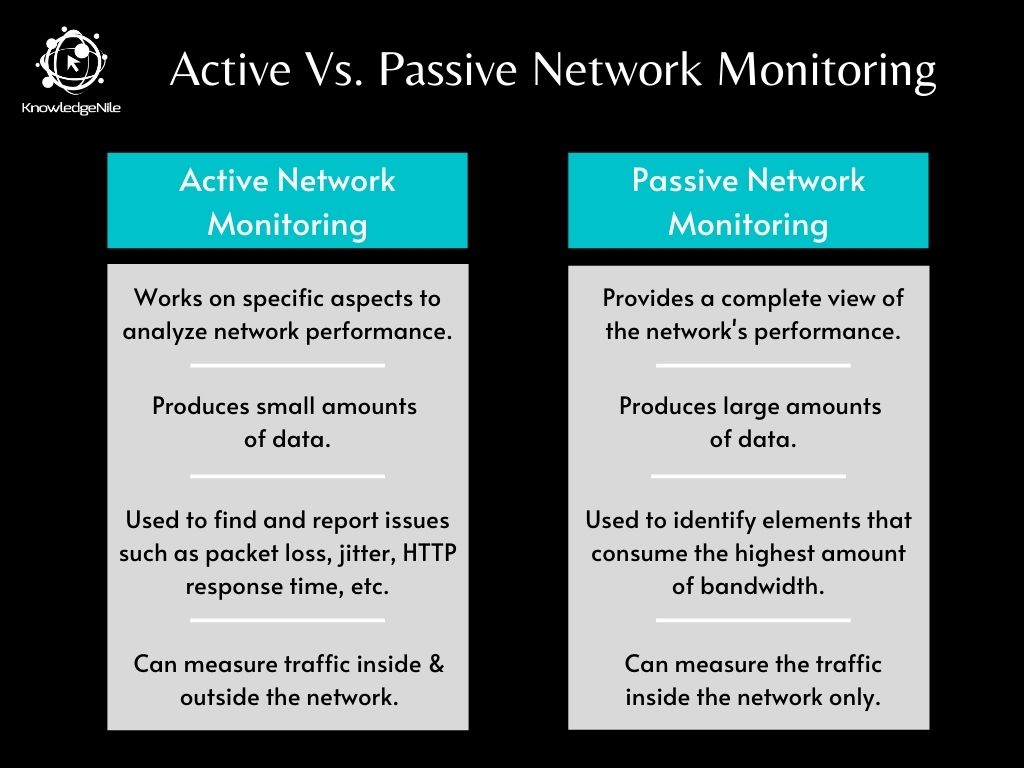In today's world, the smooth and unhindered functioning of networks is crucial to any company. The network needs to be continuously monitored. This is to ensure that all the switches, routers, firewalls, and servers are working unhampered.
All the elements need to be monitored for any discrepancies or faults. If any performance issues are found at any time, it could be fixed right away.
But, it is not a process that can be accomplished manually. For this reason, network monitoring tools come in handy.
Network monitoring tools are broadly broken down into two categories:
- Active Network Monitoring Tools
- Passive Network Monitoring Tools
Although both work towards the same goal, they use varying methodologies in their functioning.
Let's understand the working of the tools and the differences to ensure that we make the best decisions while deciding which one to choose.
Active Network Monitoring is also called Synthetic Monitoring. This method injects test traffic into the network to find faults or issues within the network.
This method helps find and report real-time data such as packet loss, jitter, HTTP response time, and so on.
Passive Network Monitoring involves recording and analyzing the actual user traffic to understand network usage trends.
With this, the tool can track which network elements are consuming the available bandwidth. It works with actual user data instead of injecting test data to analyze the traffic.
Following are some of the points of difference between the two monitoring methodologies:
Active network monitoring inserts test traffic into the network. With the help of this traffic, it finds the bottlenecks and measures the network's performance. Thus, it requires more network resources to work with.
Passive network monitoring works by capturing, storing, and analyzing the user data in the network to find usage trends. It does not require any additional data to be injected into the network. Thus, it uses lesser network resources and adds very little overhead to networking hardware.
Active monitoring generates data on particular aspects of the network to analyze the performance of the network.
On the other hand, passive monitoring provides a complete view of the network's performance. It involves analyzing historical traffic over the network.
Since Active monitoring works on specific issues, the data generated and stored is exclusively for the problem at hand. Thus, it produces smaller amounts of data.
However, passive monitoring works on historical data and hence generates and stores a large amount of data. The additional information comes in handy in resolving multiple other issues that might occur in the future.
Active monitoring ensures that the network is working efficiently. Enterprises use active monitoring to ensure the network is working at an optimum level. The users do not face any issues that might result in loss of productivity.
Passive monitoring is used to identify network elements that are consuming the highest amount of bandwidth.
Active monitoring can measure the traffic inside as well as outside the network environment.
Passive monitoring, on the other hand, can measure the traffic only inside the network.
Tabular Comparison of Active Network Monitoring and Passive Network Monitoring
Conclusion
We have now seen that neither of the monitoring tools can replace the other. They both have varying functionalities.
If you are looking for a network monitoring solution at an enterprise level, analyze what kind of issues you face to maintain your network. Based on this data, you would decide which network monitoring solution is a better fit for your enterprise.
You May Also Like to Read:






